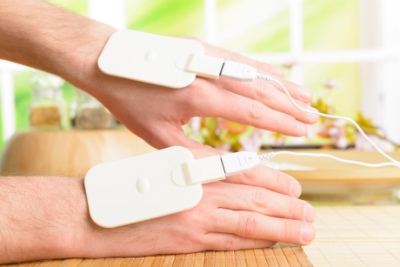Low Current Electrical Therapy
Low Current Electrical Therapy (LCET) includes a range of treatment, therapy, and testing equipment and modalities. These are designed to have a positive therapeutic physiological effect through their influence on cells, tissues, organs, nerves, joints, cartilage, and other physical structures.
Many people are aware of some of these electrically based therapies, such as TENS, for pain control, and Electrical Stimulation for the accelerated healing of bone fractures.
At Cherubino Health Center in the 1980s, we were among the first to use Low Current Electrical Therapy, LCET for its positive effects on nerve function. Electrically based therapies have continued to evolve and improve with time, testing and research.
Currently, there are a growing number of Electrotherapies based on the use of Low Current Low Frequency. Areas of global interest include, electrical therapies such as Transcranial Stimulation and Biofeedback for improved brain function and frequency generating technologies that can improve central and peripheral nervous system integration.

Low Current Electrical Therapy, (LCET)
Treatment, Therapy, and Devices
- Biofeedback Testing and Therapy
- Electro Acupuncture
- Low Frequency Electrical Stimulation
- Transcranial Direct Current Stimulation (tDCS)
- Pointer Plus
- Acu-Pen
- Piezo Devices
- Tsubo (Electromagnetic)
Biofeedback Testing and Therapy
Biofeedback testing and therapy can be used to improve physical, mental and neurological health. Historically it has been utilized in the treatment of conditions such as high blood pressure, migraine headaches and chronic pain.
With the advent of newer testing equipment, it is now being used in a many situations – from a holistic, whole person perspective.
Electro Acupuncture
Treatment of specific acupuncture, nerve, and trigger points of the body is achieved through use of non-invasive electrical stimulation and cold laser. These modalities offer the same penetration as traditional acupuncture needles without the biohazard and added stress of puncturing the skin. Treatment is safe and painless, making it suitable for a wide range of patients and conditions. Lasers used in this office are in the 620-690nm range and are safe to use without additional safety precautions.
Administration: Patient may sit or lie on a table. Fully clothed.
Duration: 5 to 15 minutes, usually in conjunction with another technique
More Info
Low Frequency Electrical Stimulation
The use of very low electrical current is an excellent preparatory technique in cases where long-standing nerve impulse deficiency and muscular tension are present. This technique is helpful in resetting the timing of localized areas of the nervous system. Rubberized carbon pads are moistened with a water-based hypoallergenic gel are applied to areas over spinal nerves. The procedure is completely painless and may not even be perceptible since most patients require sub-threshold stimulation.
Administration: Patient may sit or lie on a table. Fully clothed.
Duration: 5 to 15 minutes, usually in conjunction with another technique
Transcranial Direct Current Stimulation (tDCS)
Transcranial Direct Current Stimulation, (tDCS) works by using low current electrical stimulation to the brain and central nervous system. It has been shown to improve and enhance neurological function, and help regulate neurotransmitters including serotonin, and is a non-invasive brain stimulation technique that uses low electrical impulses. It is currently being used in the treatment of conditions ranging from anxiety, depression and other nervous system related conditions.
This technique is a noninvasive, safe, effective, and painless brain stimulation treatment that uses a constant, low intensity electrical current to improve the function of specific parts of the brain for people suffering from a variety of conditions, including but not limited to:
- Anxiety
- Depression
- Cognitive deficits
- Speech problems
- Sensory motor conditions
- Multiple sclerosis
- Post stroke
- Parkinson’s disease
- Movement disorders
- Sleep disorders
- Nervous system conditions
- Tinitus
- Other neurologically based conditions
Administration: Patient may sit in a chair or sit or lie on a table. fully clothed. Electrical contact pads are placed on the head most often on the temples.
Duration: 5 to 15 minutes, often in conjunction with another technique.
